Environmental Engineering Reference
In-Depth Information
Sleipner
The Sleipner project, illustrated in
Figure 8.4.3,
is located in the North
Sea about 250 km off the coast of Norway. This is the fi rst commercial
scale project in which CO
2
is injected into a saline formation. Similar to
the In Salah project, about 9% CO
2
is produced with the natural gas. The
saline formation into which the CO
2
is injected is a brine-saturated
unconsolidated sandstone about 800-1,000 m below the sea fl oor. The
formation also contains secondary thin shale layers, which infl uence the
internal movement of injected CO
2
. The CO
2
injection started in 1996 and
by 2013 more than 11 Mt CO
2
have been sequestered. The aim of this
project is to sequester 20 Mt CO
2
in total. The saline formation has a very
large storage capacity (1-10 Gt CO
2
) [8.6].
The fate and transport of the CO
2
plume in the storage formation has
been monitored successfully by seismic time-lapse surveys. These sur-
veys provide experimental evidence that the caprock is an effective seal
that prevents CO
2
migration out of the storage formation. In 2007 (after
Figure 8.4.3
The Sleipner CO
2
storage project
Figure from IPCC
[8.7],
reproduced with permission.

















































Search WWH ::

Custom Search